by Ron Ploof | Mar 15, 2020 | Business Storytelling
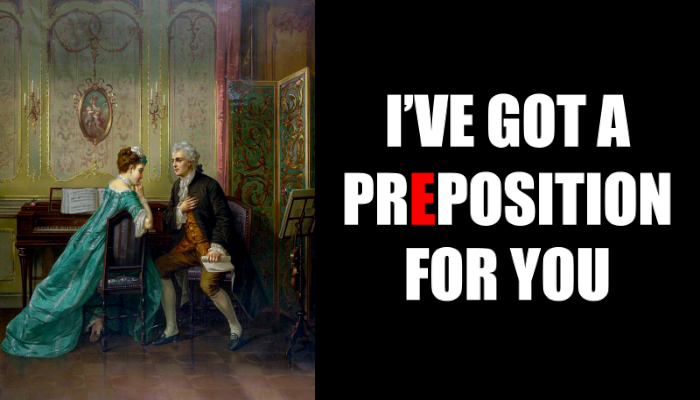
It’s called the Big Idea–the foundation of any best-selling book, blockbuster movie, or TED Talk. They’re frequently found in rare Ah-ha! moments, when clarity emerges unexpectedly from sustained periods of doubt and frustration. And while the euphoric rush from such flashes is intoxicating, the emotional high is short-lived once the discoverer contemplates the daunting task of explaining it to someone else.
Experienced authors, storytellers, and keynote speakers know that sharing big ideas is harder than discovering them. Why? Because big ideas are built upon personal life experiences, while the messages crafted to represent them must be filtered through a listener’s unique life experiences.
So, how do we convert complex concepts–some which may have taken us years to develop–into works that resonate with large numbers of people? The secret is found in the everyday words we use to describe the human condition: prepositions.
While it’s trendy in today’s world to highlight our differences, we find a universal core under all those layers: all 7.64 billion of us of were born and have evolved into the beings we are today. Although that statement may sound simple, consider that each one of us has impossibly derived the SAME big idea from our billions of experiences. “We are physical beings, bounded and set off from the rest of the world by the surface of our skins, and experience the rest of the world as outside us. Each of us is a container, with a bounding surface and an in-out orientation onto other physical objects that are bounded by their surfaces. Thus, we also view them as containers with an inside and an outside.”1
This notion of inside and outside–or the state of actually being inside or outside–is an extraordinary complex idea. Having shorthand like in and out to describe our physical locations is a life imperative, which is probably why they’re the seventh and forty-third most common words used in the English language.2 We–and I mean all 7.64 billion of us–then bootstrap our understandings of new concepts from our deep connection to these two words.
For example, let’s take a look at the seemingly incongruous concept of being inside and outside simultaneously. We can be inside a warm coat, while outside of our home. This knowledge leads to another concept: transition–the fact that we can move back into our houses and out of our coats…and vice versa.
Everyday experiences teach us something new. We’ve learned that our environment affects us. The “simple” act of walking involves an constant struggle between our wills to remain upright and an invisible force that pulls us downward. Although children don’t fully understand the force of gravity–actually, the world’s best physicists still don’t–we accept it as an inescapable part of the human condition. As a result, when we fall down, we’re expected to get back up.
And so we add up and down to our list of tiny words used to describe life experiences. But up and down carry other connotations. Since the act of falling down is unpleasant and getting up is better, we associate up as good and down as bad. Thus, when we’re asked to describe another complex concept such as mood, we answer with seemingly nonsensical things like, “I’m feeling up today,” or “I’ve been down for a while.” Yet, no matter how illogical it may seem to describe emotional states using orientational words, we get it because we’ve all lived it.
The more experiences we have, the more concepts we need to express. For example, consider the impossibly complex concept of love. We can be in or out of it. Actually, we can fall into or out of it, suggesting that love is some sort of container with an inside and an outside. But that’s not exactly right because we can be in love and still hold love in our hearts…again…simultaneously! And just when we’re comfortable with love being a container, Pat Benatar tells us that love is a surface because Love is a Battlefield.
Love is such a vital yet complex concept, prior generations have written plays, books, songs, and proverbs to describe it.
In addition to being a container and a surface, love appears to be a force because Love makes the world go ’round, Love conquers all, and Love makes the impossible possible. This mysterious container/place/force also seems to have cognitive abilities because Love understands all languages. And while love is a force that can understand, it also has the ability to cloud our judgement as Love makes a good eye squint.
1 Corinthians 13: 4-7 describes love as a best friend who’s patient, kind, humble, respectful, forgiving, truthful, trusting, hopeful and persistent. With all of these definitions as a container/surface/force with friend-like cognitive abilities, it’s a wonder that we have any understanding of what love is at all.
But we do, because the longer we experience the human condition, the more opportunities we have to experience love’s infinite facets.
So, you wanna share a big idea? Start with the words used to describe our relationship to the human condition: prepositions. Prepositions will eventually lead to metaphors–the building blocks of all human understanding.
Do so by asking yourself a few questions about your big idea:
- How might I represent my big idea as an object, substance, container, surface, event, action, activity, or state?
- Does it have an inside, outside, top, or bottom that allows us to be in, out, on, off, over, or under it?
- Does it come with some things and/or without others?
- Is it stationary or does it move? If it moves, does it move toward or away?
- Are there any advantages or disadvantages to being by, at, or near it?
- How is it viewed? Do we look up, down, or sideways at it?
- Is it part of a process, where something happens before or after it?
- Is it the cause of something or the result of something else?
- Did it emerge from something or does something emerge from it?
- Is it adversarial? Perhaps it’s for something and against something else?
When trying to convey a big idea, forget the big words and apply a laser-like focus on the small ones that we as humans rely upon daily. Prepositions lead to metaphors and metaphors lead to universal meaning.
Notes:
1. George Lakoff and Mark Johnson, Metaphor We Live By (University of Chicago Press, 2003) Kindle e-book location 521/4362
2. https://en.wikipedia.org/wiki/Most_common_words_in_English
Photo Credit: A. & C. Kaufmann, and Otto Erdmann. Proposal / original by Otto Erdmann ; chromo-lithographed and published by A. & C. Kaufmann, 366 Broadway, New York. , ca. 1873. New York: Published by A. & C. Kaufmann, 366 Broadway. Photograph. https://www.loc.gov/item/99400105/
by Ron Ploof | Mar 1, 2020 | Business Storytelling
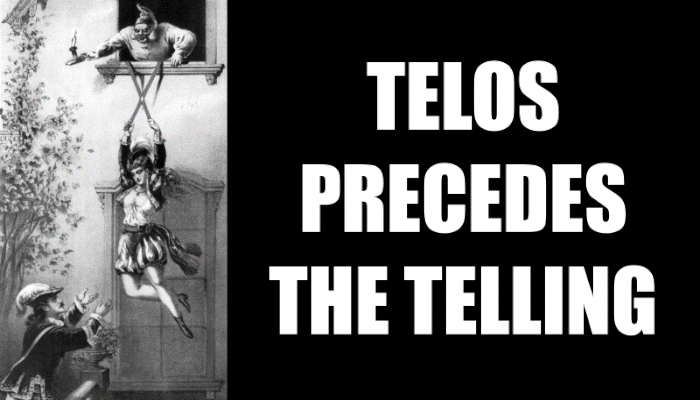
Studying words from other languages is useful because they often capture a meaning that may not translate directly into one’s native tongue. Today’s example comes from the Greek word telos, which loosely translates to goal or end, but more accurately embodies the concept of the ultimate goal or the ultimate end.
According to Aristotle, telos resides in everything animal, vegetable, or mineral, and somehow, each one works in concert. While a rabbit’s telos may be to survive, it can only do so through a complementary collection of internal telos, like remaining safe, finding food, and reproducing. And although the telos of vegetables and minerals may not involve bunny-consciousness, they each play a role in feeding the rabbit’s hunger and forming a cave for the rabbit’s family to live in.
Let’s take a look at the role of telos in communicating. You’ve been tasked with presenting the results of your most recent project. So, what’s your telos? By the time you thank your audience for their time, what do you want them to walk away with? Is it to look at an issue from another perspective, change the way they’re doing things, or encourage them to double down on a controversial action because it’s the right thing to do?
Unfortunately, most people skip the telos step, preferring to jump right into the recitation of fact after tactical fact. Sadly, the telos of most presentations is to “get it out of the way” instead of conveying a subject’s deeper meaning.
For example, I recently found myself in the audience of a dreadful business presentation. When the presenter noticed that he’d completed his talk fifteen minutes ahead of his one-hour time slot, he said, “Wow! I thought I had too many slides!” Obviously his telos wasn’t to communicate, but to create enough slides to fill the time allotted.
To be fair, telos-driven talks require work that most people don’t think that they have the time to invest. But in reality, every presentation is a pay-telos-now-or-pay-telos-later situation. The less telos pre-work presenters put into their presentations, the more audiences must asses their own telos by asking internal questions such as:
- How does this information apply to me?
- Why am I sitting here?
- When is catering restocking that refreshments table?
Storytelling telos plays a fundamental role in my various interactions with people:
- The telos of my lectures is to teach a certain message.
- The telos of my opening stories is to bond with my audience.
- The telos of a story told over a pint of beer is usually to entertain.
- The telos of a Griddlecakes Radio story is to convey a life-lesson that a specific experience taught me.
Before you present, ask yourself, What’s my telos? Is it to add moisture to a dry subject, such as was my telos for writing The Proverb Effect? Is it to add personality to data, change a perspective, or to bond over a common experience?
Whichever way you choose, telos-driven communications strategies also contain a built-in quality control mechanism. When used, you’ll always be able to look back on a presentation and determine whether you were successful or not.
Image Credit: Metallic End Suspenders. , ca. 1874. Photograph. https://www.loc.gov/item/2001701469/.
by Ron Ploof | Feb 17, 2020 | Business Storytelling
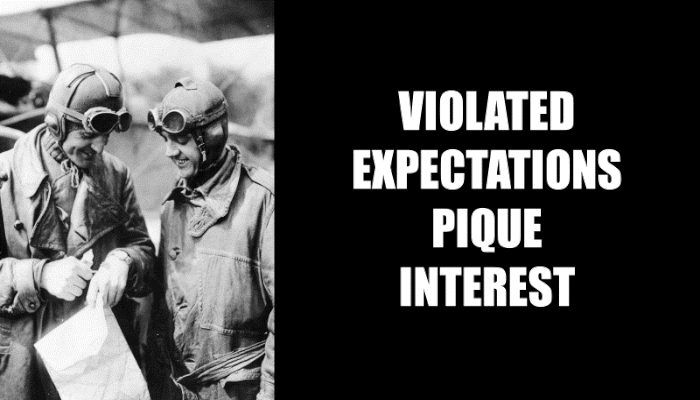
Recently, I’ve noticed an increase in the number of people expressing versions of the same phrase:
“That’s an interesting question, Ron.”
At first I didn’t think much about it. But as I heard the question more frequently, I started wondering, “Why do they find my questions interesting?”
I kept coming back to the same answer: Storytellers are masters of making things interesting. Consider that a storyteller can keep you staring at a flickering screen for two hours in a darkened room filled with strangers. Story has the power to keep a group of squirrelly children fixated on a teacher reading a book to them. And story is the reason you’ll spend days or weeks digesting a three hundred page novel.
You see, storytellers know how to actuate the neurons responsible for a piquing a listener’s interest. And once you know this secret, you can too. So, do you want to know how to do the same?
It’s simple. Violate people’s expectations. Show them something that they didn’t expect. Zig when they expect you to zag. Whisper when they expect you to scream at the top of your lungs. Stand when they expect you to duck.
All stories start when someone’s expectations are violated and it can be tracked back to Kenn Adam’s trusty Story Spine:
Once upon a time,
Everyday,
Then one day,
And because of that,
And because of that,
Until finally,
And ever since that day.
Then one day separates ho-hum from interesting. Let’s try it out.
Once upon a time, Jane would drive to work
Everyday, she’d arrive on time
Then one day, she…
- Got a flat tire
- Decided to take a detour
- Got delayed by a rogue herd of goats
All stories start by violating someone’s expectations. And there’s a corollary to this rule: Anger piques when our metaphors are violated.
If you find yourself getting heated, it’s likely because someone violated a fundamental belief that you live by. Maybe you expected someone to act a certain way and yet they didn’t. Perhaps someone cut in line, spoke to you condescendingly, or acted recklessly, thus placing you or others in unnecessary danger. If someone violates a metaphor that guides your personal definition of right and wrong, your natural instinct will be to react swiftly and emotionally.
So, why are people finding my questions interesting? I guess because I’m injecting my experience as a storyteller into the conversation. I’m constantly trying to understand the motivations of the players involved. If a long-time satisfied customer suddenly changes behavior by making odd emotional requests, rather than reacting defensively, I’ll ask my colleagues questions like:
- What are they trying to accomplish with this request?
- What is the real source of their frustration?
- What core beliefs might we have violated accidentally?
I’m finding that this line of questioning helps my coworkers not only address the problem from a new perspective, but they also start asking their own interesting questions.
Photo Credit: Photograph of Army Air Corps pilots Maj. Reuben Fleet and Lt. George Boyle on May 15, 1918 ; National Postal Museum, Benjamin Lipsner Collection. Photographer: Unknown.
by Ron Ploof | Jan 18, 2020 | Business Storytelling
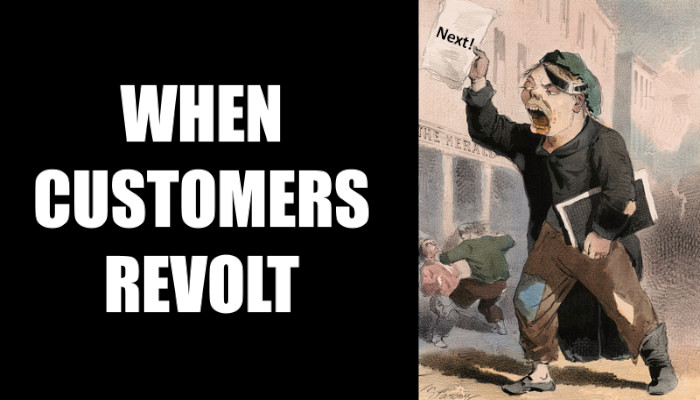
The presentation began as most do. The presenter began flipping through a series of PowerPoint slides that he’d pulled from the company’s internal marketing database. They contained all the traditional basics, including the dreaded We Are the World opening–ya know–the one that makes your company sound like a Clint Eastwood character in a spaghetti western?
Most of the time, customers sit dutifully through these sycophantic preambles…well, except for this day…when one of the customers decided to add color commentary.
“Yeah, we know that you’re the best. You wouldn’t be here otherwise.”
The presenter smiled and advanced to the next slide that talked about the company’s quality.
“Quality? Well, I sure hope so,” the customer said sarcastically.
The presenter advanced to the next slide that contained platitudes of industry dominance.
“Look, we know that you’re awesome and everyone loves you. Can we move on?” The now-emboldened customer proceeded to bark the word, “NEXT!” with each subsequent self-aggrandizing slide.
I find it astonishing that more than ten years into the Content Marketing movement, marketers haven’t relocated their We are the World sections to the appendices of their presentations. Is the information important? Sure. Purchasing from the industry leader is an important piece of information for a buyer–but only AFTER customers conclude that the product meets their requirements. Putting the bravado-cart before the functional-horse is not only unproductive, it’s disrespectful to audiences who are obviously no longer willing to sit passively.
Take a look at your most recent marketing presentations. Do they contain We are the World sections? If so, would it really hurt to move them to the appendix as backup sides?
Photo Credit: Sarony & Major, Lithographer. One of the news-b’hoys / Lith. of Sarony & Major. New York, 1847. New York: Published by T.W. Strong. Photograph. https://www.loc.gov/item/2003664125/.
by Ron Ploof | Jan 5, 2020 | Business Storytelling, Linguitics
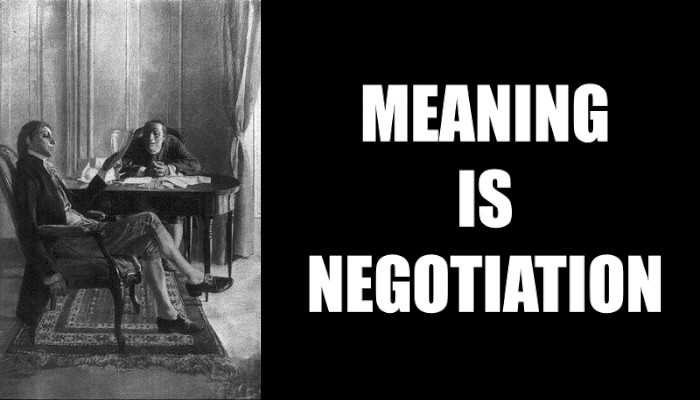
Have you ever stated your case so clearly that you knew with certainty that you nailed it? And while you were celebrating your superior communication achievement, have you ever found yourself standing in front of someone who just didn’t get it…at all? If so, you’ve probably fallen victim to a metaphorical mismatch.
Humans use metaphor–the ability to define one thing in terms of something totally different–to understand complex ideas. Essentially, we build upon the concepts learned through the human condition.
Think about the concept of time. Everyone knows what time is because we experienced it everyday. However, if I pressed you to define it, I bet you’d struggle. Exactly how does one describe something we can’t see, hear, smell, touch, or taste?
That’s where metaphor comes in. Rather than describing time directly, we represent it metaphorically through the various ways it affects our lives. For example, we know that time has:
- Inevitability: There’s nothing that we can do to stop it
- Motion: Time moves from the past, through the present, and into the future
- Direction: We can look back in time to see where we’ve been and forward to predict where we’ll be
- Duration: We’re accustomed to waiting for a process to finish
- Distance: We describe long time durations in terms of distance, such as looking far into the future or way back in the past
- Physical effect: We are born young and small, then grow up to become big and old
- Value: We know that our time is limited, and therefore is a precious commodity. We’re even paid for our time.
Try finding a few of your own.
The concept of time is so deep, it’s highly likely that all metaphorical references won’t be shared among all people. For example, an old person with less time in front of them may disagree with the statement that “There will be plenty of time to do X, Y, or Z.” . Or, no matter how much truth contained in “Don’t worry, things will get better with time,” someone who’s just suffered a tremendous loss won’t react well to the statement.
If your audience doesn’t believe in the metaphorical bricks that you have built your premise upon, your idea will not only be dead on arrival, but your ability to share your concept will suffer a setback. Consider the worldviews of our example old and young people. By definition, the former has more life experience than the latter, yet many of those life experiences don’t align. While the older person has lived through their twenties, they didn’t live through the twenties in this century. Thus, by choosing to communicate using 20th-century metaphors on 21st-century belief systems risks instant slap-backs, as in with the trendy “Okay, Boomer.”
Metaphor is a negotiation because it requires speakers to understand the worldview of their listeners before stating a case. Without understanding your listener’s metaphorical belief structure, it’s easy to step into a hornets nest of misinterpretation.
The conveyance of meaning is fickle because we each interpret information differently. Your goal as a communicator is to find the best metaphor through testing and conversation. If you can find a similar–not necessarily identical–life experience to build your complex concept upon, you’ll have found a successful frame of reference to base your argument.
Photo Credit: Benjamin Franklin and Richard Oswald discussing the Treaty of Peace Paris. , 1898. Photograph. https://www.loc.gov/item/2004674949/.
by Ron Ploof | Dec 28, 2019 | Business Storytelling, Storytelling
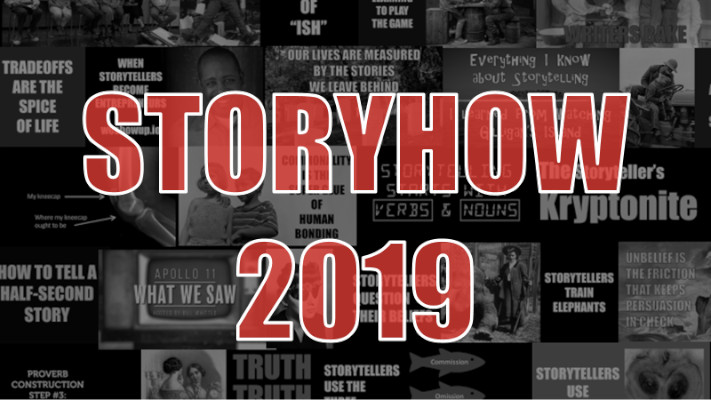
Our goal at the StoryHow Institute is to be your one-stop resource to help you become a better communicator. We fulfilled our promise in 2019 through publishing 22 articles with much more planned for 2020. Next month, Ron will be releasing a new deck of cards called the Proverb Construction KitTM (finally!). He’s researching two new books and is writing a specialized version of the StoryHow PitchDeckTM.
We look forward to serving your storytelling needs in the new decade.
Here’s a recap of StoryHow in 2019:
1. Proverb Construction Step #3: The Finish
This final post in a three-part series helps put the finishing touches on your self-created proverbs.
2. Storytelling Lessons from the Game: Two Truths and a Lie
The Icebreaker, Two Truths and a Lie, teaches great lessons in storytelling.
3. Storytellers use the Three Red Herrings
Storytellers are experts in ethical deception.
4. Storytellers use Apophenia
Apophenia, the human’s propensity to see patterns where none exist, is a powerful tool for your storytelling toolbox.
5. How to tell a story in a half-second
It’s called the startle response, the most basic human response to unfamiliar stimuli. Not only does it form the basis of all human understanding, but it forms the roots of storytelling
6. Commonality is the Super Glue of Human Bonding
Ron looks in to why finding something in common with a total stranger is the quickest way to bond.
7. The Storyteller’s Kryptonite
New study reveals that ad hominem attacks are the kryptonite of human communications
8. Unbelief is the Friction that Keeps Persuasion in Check
Although naysayers can blow up an argument through simple character assassinations, chief negotiator Chris Voss offers an antidote.
9. Storytelling Starts with Verbs and Nouns
Ron finds storytelling advice from one of the oddest places, the design engineers on the Apollo space program.
10. Storytellers Train Elephants
Before you step into the three ring circus of storytelling, you might want to brush up on your elephant training skills.
11. Who Knew Storytelling Could Be so Dangerous
Ron goes back to his storytelling roots with the release of his latest podcast episode on Griddlecakes Radio.
12. Storytellers Question Their Beliefs
If you still believe something after five years, question it. You’ll either learn something new about it, or change the view entirely. Both are good for storytellers.
13. Storytelling at its Finest, Apollo 11: What We Saw
Sometimes the best way to learn storytelling is to study the works of others. Ron goes card-by-card through the StoryHow(TM) PitchDeck to see how Bill Whittle used Roles, Events, Influences, and Techniques in his storytelling masterpiece, Apollo 11: What We Saw.
14. When Storytellers Become Entrepreneurs: weshowup.io
Storytellers bring new perspectives to the great game of business. Kahlil Ashanti is changing the way tickets are priced with his company, weshowup.
15. Our Lives Are Measured by the Stories We Leave Behind
Life is a great story, with plots, subplots, twists and turns. The best ones set themselves deeply into our memories. What are your favorite ones?
16. Tradeoffs are the Spice of Life
While marketers want to tell ideal stories, more often than not, their customers choices are less than ideal.
17. Why AI Scientists Must Study Storytelling
While deep neural networks can perform amazing functions, artificial intelligence has a long way to go to match the robustness of human intelligence. Ron Ploof, suggests that the path to achieve such robustness is found through storytelling.
18. Everything I know about Storytelling I learned from Gilligan’s Island
How do you create a great story that connects across generations? By studying a successful one. Ron analyzes the television show, Gilligan’s Island, using the StoryHow™PitchDeck.
19. Golden Nuggets from UCI’s Center for Storytelling
UCI School of the Humanities introduced its Center for Storytelling through an inaugural event called, Telling Stories that Matter. Here are some notes from that event.
20. The Tyranny of “ish”
An insidious trend that creeps under the auspices of protection is threatening human communication. But what exactly is it protecting us from?
21. Fool Me Once: Learning to Play the Game
Have you ever been taken advantage of? Have you ever been cheated, lied to, or deceived? At some point in our lives, someone uses our trust against us and we’re disappointed, hurt, and left somewhat jaded. Ron returns to his audio storytelling roots tell the story of being scammed and the lessons that he’s learned through the experiences
22. Storytellers Cook. Writers Bake.
It’s common to think of storytelling and writing to be interchangeable. They’re not. Ron examines the fundamental differences between writers and storytellers.





